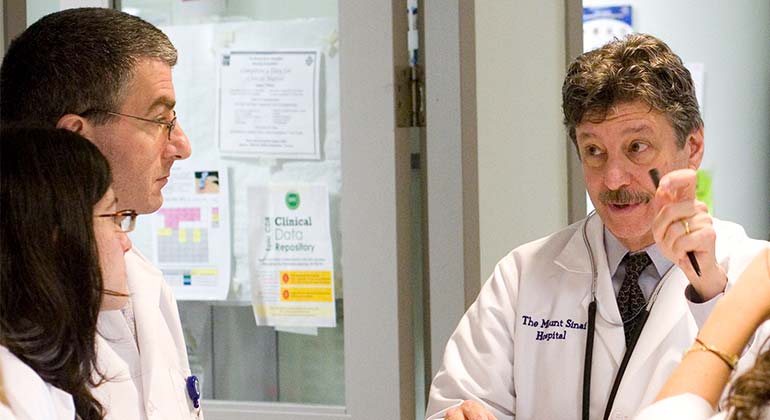Myelodysplastic Syndrome

What is Myelodysplastic Syndrome (MDS)?
The Myelodysplastic Syndrome (MDS) is a relatively rare form of blood and bone marrow cancer. Myelodysplastic Syndromes (MDS) are a group of diverse bone marrow disorders in which the bone marrow does not produce enough healthy blood cells. Most people have heard of leukemia, and MDS was once thought of as early-stage leukemia. Today, it is considered a type of cancer on its own. "Myelo" refers to the cells in the blood and bone marrow. “Dysplastic” means abnormal. Mount Sinai physicians and researchers including Lewis R. Silverman, M.D and James F. Holland, M.D., have been in the forefront of understanding MDS, and gained FDA approval for the first drug to treat MDS, called Vidaza® or azacitidine.
While MDS typically occurs in patients in their mid-60s to 70s, it can affect people at any age. It can show up in many different forms. MDS represents a group of closely-related diseases characterized by a failing bone marrow, and low blood counts leading to infection and bleeding. To understand MDS, it is helpful to know how blood cells are formed, and the role the different blood cells play.
Your bone marrow replenishes blood cells
The bone marrow is the “factory” that produces all the blood cells. Blood has to be replenished continually because blood cells only last from a couple days to a few months, depending on the type of cell. In myelodysplastic diseases, the blood stem cells do not mature into healthy red blood cells, white blood cells, or platelets. The immature blood cells, called blasts, do not work the way they should and die in the bone marrow or soon after they enter the blood. As a result, there are fewer healthy red blood cells, white blood cells, and platelets. A normal person replaces 1% of their red blood cells every day. If your bone marrow fails to produce blood cells, then your blood count starts to go down. As a consequence of declining marrow production, a person could develop low red cell counts, low white cell counts or low platelet counts.
- Red blood cells carry oxygen throughout the body
- White blood cells fight infection and help with healing
- Platelets help control bleeding and help heal cuts or nicks on skin or mucosa (gums, nose, or gut)
Having too few red blood cells is called anemia, and can leave a person feeling tired, weak and short of breath. Too few white blood cells can lead to severe infections. Platelets help your blood clot—and with too few, you can be at risk for both excessive bleeding and bruising.
MDS starts in the bone marrow
Blood cells start as stem cells within the bone marrow. In patients that have MDS, the environment within the bone marrow becomes abnormal. The blood cells cannot be formed naturally, and are produced inefficiently or abnormally. Often, they are formed within the bone marrow, but do not survive long enough to leave and become mature cells in the bloodstream.
With MDS, there are often genetic mutations or defects that occur in the bone marrow cells. The variety of genetic disorders can create many different issues in blood cell production, which vary among individuals. This is why MDS is not just one disease. The behavior of the disease can be very different from one individual to another due to these genetic differences. The interaction between the bone marrow and the production of blood cells is complex, and physicians need to consider a variety of factors to recommend the best course of treatment.
Treating MDS at Mount Sinai
Patients with MDS may have “lower risk” MDS or “higher risk” MDS. With lower risk MDS, patients may just be kept under observation by the physician. The behavior of MDS in these patients may be stable for several years and not require immediate treatment. With higher risk MDS, there are a range of treatments available. Supportive care may include transfusions to raise blood counts, while aggressive treatments can include a variety of drugs or stem cell transplants.
At Mount Sinai, we continue to do new clinical and laboratory research to understand what physiology or mechanisms drive MDS. We are constantly searching for new drugs for the next breakthrough. And we test drugs, singly and in combination, in the laboratory and in clinical trials to discover more effective treatments.
The work in the laboratories here at Mount Sinai first demonstrated the concept that cancer cells can be reprogrammed. Treatment of cancer cells can change their behavior from cells that grow in an uncontrollable manner into cells that begin to function normally and stop growing naturally. Under the leadership of Dr. Lewis R. Silverman at Mount Sinai, doctors used this approach to treat patients with MDS and demonstrated that this treatment with a drug called azacitidine or Vidaza, could be effective in patients. After several national and international trials led by Dr. Silverman and his team, azacitidine was approved by the FDA as the first treatment for patients with MDS. Today azacitidine is the standard of care for patients with high risk MDS.
Mount Sinai continues to provide leadership in research in MDS and provides individualized, and precision-targeted therapy options for patient with all forms of MDS, from low to high risk disease, as well as those that have transformed to acute leukemia. Treatments include investigational new drugs, combinations, immune therapies and stem cell transplants. Our teams include physicians, nurses, researchers, social workers, pharmacists, and laboratory scientists all focused on developing new insights and treatments for MDS.
